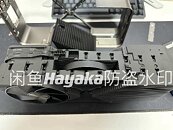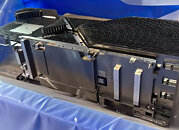- Joined
- Oct 9, 2007
- Messages
- 47,295 (7.53/day)
- Location
- Hyderabad, India
| System Name | RBMK-1000 |
|---|---|
| Processor | AMD Ryzen 7 5700G |
| Motherboard | ASUS ROG Strix B450-E Gaming |
| Cooling | DeepCool Gammax L240 V2 |
| Memory | 2x 8GB G.Skill Sniper X |
| Video Card(s) | Palit GeForce RTX 2080 SUPER GameRock |
| Storage | Western Digital Black NVMe 512GB |
| Display(s) | BenQ 1440p 60 Hz 27-inch |
| Case | Corsair Carbide 100R |
| Audio Device(s) | ASUS SupremeFX S1220A |
| Power Supply | Cooler Master MWE Gold 650W |
| Mouse | ASUS ROG Strix Impact |
| Keyboard | Gamdias Hermes E2 |
| Software | Windows 11 Pro |
Amidst reports that NVIDIA has shelved plans to release a new flagship RTX 40-series graphics card to top the current RTX 4090, we are getting even more pictures of the company's ingenious product design for what could have been the GeForce RTX 4090 Ti, or RTX TITAN (Ada). Pictures of the card's cooling solution has been in the news since January 2023, with more images surfacing in June. We are getting our first images of the cooler disassembled, revealing a startling look at the engineering effort NVIDIA put into this thing.
As we mentioned earlier, the "RTX 4090 Ti" features a unique ruler-shaped PCB that's oriented along the plane of the motherboard, rather than perpendicular to it, like any other add-on card. This is to minimize the spatial footprint of the PCB, and maximize volume for the cooler—which is 4 slots, thick, with its entire thickness dedicated to heat-dissipation, and no obstruction posed by the PCB.





Disassembling the cooler reveals that it has a large, continuous aluminium fin-stack spanning the entire length of the card. These fins are along the plane of the motherboard, just like the card's PCB. A jaw-dropping 22 heatpipes pull heat from the base plate that makes contact with all hot components on the PCB, including the GPU, VRM, and memory; spreading heat along the fin-stack.

The base-plate (from an older article), is a large continuous block of nickel-plated copper, with mirror finish over the contact-points where the card's "AD102" GPU, twelve GDDR6X memory chips, and numerous DrMOS components make contact with the card. It is from here that the 22 heatpipes pull heat.
There are a total of three fans—one of them is an intake located toward the obverse side of the card, which draws in fresh air; one of them is toward the tail-end, pulling hot air through the fin-stack, and exhausting through the reverse side of the card; the third one is a conveyor fan, located bang in the middle of the fin-stack, its airflow intersects both the other fans. The airflow from all three fans goes right through the fin-stack, unobstructed by the PCB along the way.
The RTX 4090 Ti has three breakout components besides the PCB. The first of these is a PCI-Express 4.0 x16 finger that's perpendicular to the PCB, so the card slots into your motherboard like just another add-on card. The second component is a satellite PCB located along the top of the card, with its 16-pin 12VHPWR power connector.
The third component is an innovative new cable that connects the power receptacle PCB with the card's main PCB. This is a series of two flattened non-braided copper cables conveying the 12 V DC power from the connector to the PCB in a 2-pin format. Each of the two cables is capable of 600 W continuous delivery, along with excursions within the ATX 3.0 specification. Besides the two power cables, you have the four signal pins from the 12VHPWR being conveyed to the PCB using a thinner set of cables.
NVIDIA went through all this trouble to create a cooling solution capable of taming a maxed out "AD102" GPU with all its 72 TPCs (144 SM) or 18,432 CUDA cores enabled. The card would find its place in NVIDIA's product stack had the Radeon RX 7900 XTX posed a threat to the RTX 4090 (it doesn't). It remains to be seen by how much AMD pushes up the performance of the already maxed out "Navi 31" GPU in the upcoming Radeon RX 7950 XTX, so NVIDIA could find a reason to respond with this card.
View at TechPowerUp Main Site | Source
As we mentioned earlier, the "RTX 4090 Ti" features a unique ruler-shaped PCB that's oriented along the plane of the motherboard, rather than perpendicular to it, like any other add-on card. This is to minimize the spatial footprint of the PCB, and maximize volume for the cooler—which is 4 slots, thick, with its entire thickness dedicated to heat-dissipation, and no obstruction posed by the PCB.





Disassembling the cooler reveals that it has a large, continuous aluminium fin-stack spanning the entire length of the card. These fins are along the plane of the motherboard, just like the card's PCB. A jaw-dropping 22 heatpipes pull heat from the base plate that makes contact with all hot components on the PCB, including the GPU, VRM, and memory; spreading heat along the fin-stack.

The base-plate (from an older article), is a large continuous block of nickel-plated copper, with mirror finish over the contact-points where the card's "AD102" GPU, twelve GDDR6X memory chips, and numerous DrMOS components make contact with the card. It is from here that the 22 heatpipes pull heat.
There are a total of three fans—one of them is an intake located toward the obverse side of the card, which draws in fresh air; one of them is toward the tail-end, pulling hot air through the fin-stack, and exhausting through the reverse side of the card; the third one is a conveyor fan, located bang in the middle of the fin-stack, its airflow intersects both the other fans. The airflow from all three fans goes right through the fin-stack, unobstructed by the PCB along the way.
The RTX 4090 Ti has three breakout components besides the PCB. The first of these is a PCI-Express 4.0 x16 finger that's perpendicular to the PCB, so the card slots into your motherboard like just another add-on card. The second component is a satellite PCB located along the top of the card, with its 16-pin 12VHPWR power connector.
The third component is an innovative new cable that connects the power receptacle PCB with the card's main PCB. This is a series of two flattened non-braided copper cables conveying the 12 V DC power from the connector to the PCB in a 2-pin format. Each of the two cables is capable of 600 W continuous delivery, along with excursions within the ATX 3.0 specification. Besides the two power cables, you have the four signal pins from the 12VHPWR being conveyed to the PCB using a thinner set of cables.
NVIDIA went through all this trouble to create a cooling solution capable of taming a maxed out "AD102" GPU with all its 72 TPCs (144 SM) or 18,432 CUDA cores enabled. The card would find its place in NVIDIA's product stack had the Radeon RX 7900 XTX posed a threat to the RTX 4090 (it doesn't). It remains to be seen by how much AMD pushes up the performance of the already maxed out "Navi 31" GPU in the upcoming Radeon RX 7950 XTX, so NVIDIA could find a reason to respond with this card.
View at TechPowerUp Main Site | Source


 such a Behemoth !
such a Behemoth !


 And for what?
And for what? 